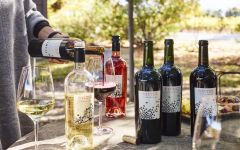Blackbird Vineyards Illustration Proprietary Red 2010
-
Wine
Enthusiast -
Wine
Spectator


Product Details
Your Rating
Somm Note
Winemaker Notes
Professional Ratings
-
Wine Enthusiast
There's something enormously satisfying about this Merlot-based blend. It hits the Napa-Bordeaux sweet spot, with concentrated blackberry and cherry fruit, jacketed in sweet, smoky oak. But there's also a fascinating olive character. The tannins are rich and dense and velvety. Great to experience now, and should be one for the long haul, perhaps through 2022.
-
Wine Spectator
Tightly focused and well-built, with aromas of cherry, blueberry and black olive, offering firm flavors of loamy mineral, cedar and currant that finish with firm tannins. Merlot, Cabernet Franc and Cabernet Sauvignon.
Other Vintages
2014-
Connoisseurs'
Guide
-
James
Suckling -
Robert
Parker
-
Robert
Parker -
James
Suckling
-
Wine
Enthusiast
-
Wine
Enthusiast
-
Wine
Enthusiast -
Robert
Parker
-
Wine
Enthusiast -
Robert
Parker -
James
Suckling
-
Robert
Parker -
Connoisseurs'
Guide -
Wine
Spectator

With hundreds of red grape varieties to choose from, winemakers have the freedom to create a virtually endless assortment of blended red wines. In many European regions, strict laws are in place determining the set of varieties that may be used, but in the New World, experimentation is permitted and encouraged resulting in a wide variety of red wine styles. Blending can be utilized to enhance balance or create complexity, lending different layers of flavors and aromas. For example, a red wine blend variety that creates a fruity and full-bodied wine would do well combined with one that is naturally high in acidity and tannins. Sometimes small amounts of a particular variety are added to boost color or aromatics. Blending can take place before or after fermentation, with the latter, more popular option giving more control to the winemaker over the final qualities of the wine.
How to Serve Red Wine
A common piece of advice is to serve red wine at “room temperature,” but this suggestion is imprecise. After all, room temperature in January is likely to be quite different than in August, even considering the possible effect of central heating and air conditioning systems. The proper temperature to aim for is 55° F to 60° F for lighter-bodied reds and 60° F to 65° F for fuller-bodied wines.
How Long Does Red Wine Last?
Once opened and re-corked, a bottle stored in a cool, dark environment (like your fridge) will stay fresh and nicely drinkable for a day or two. There are products available that can extend that period by a couple of days. As for unopened bottles, optimal storage means keeping them on their sides in a moderately humid environment at about 57° F. Red wines stored in this manner will stay good – and possibly improve – for anywhere from one year to multiple decades. Assessing how long to hold on to a bottle is a complicated science. If you are planning long-term storage of your reds, seek the advice of a wine professional.

As one of Napa’s coolest sub-appellations, the area begs for diversity among its vineyards. Merlot and Chardonnay firmly compete with Cabernet Sauvignon for a place here. Some of Napa’s best Zinfandels also come from the Oak Knoll District.
Situated far in Napa’s southern end, Oak Knoll receives a strong cooling influence from both the San Pablo Bay and the Pacific Coast’s evening fog and breezes. Summer days are warm but on average ten degrees cooler than in St. Helena farther north up the valley; summer nights are chilly. A long growing season promotes for leisurely ripening of grape berries, resulting in an impressive balance of sugars, phenols and acidity.
Notable producers include Trefethen, one of the appellation’s oldest wineries, Robert Biale, legendary Zinfandel producer and Lewis Cellars, a family-run, hands-on establishment.




